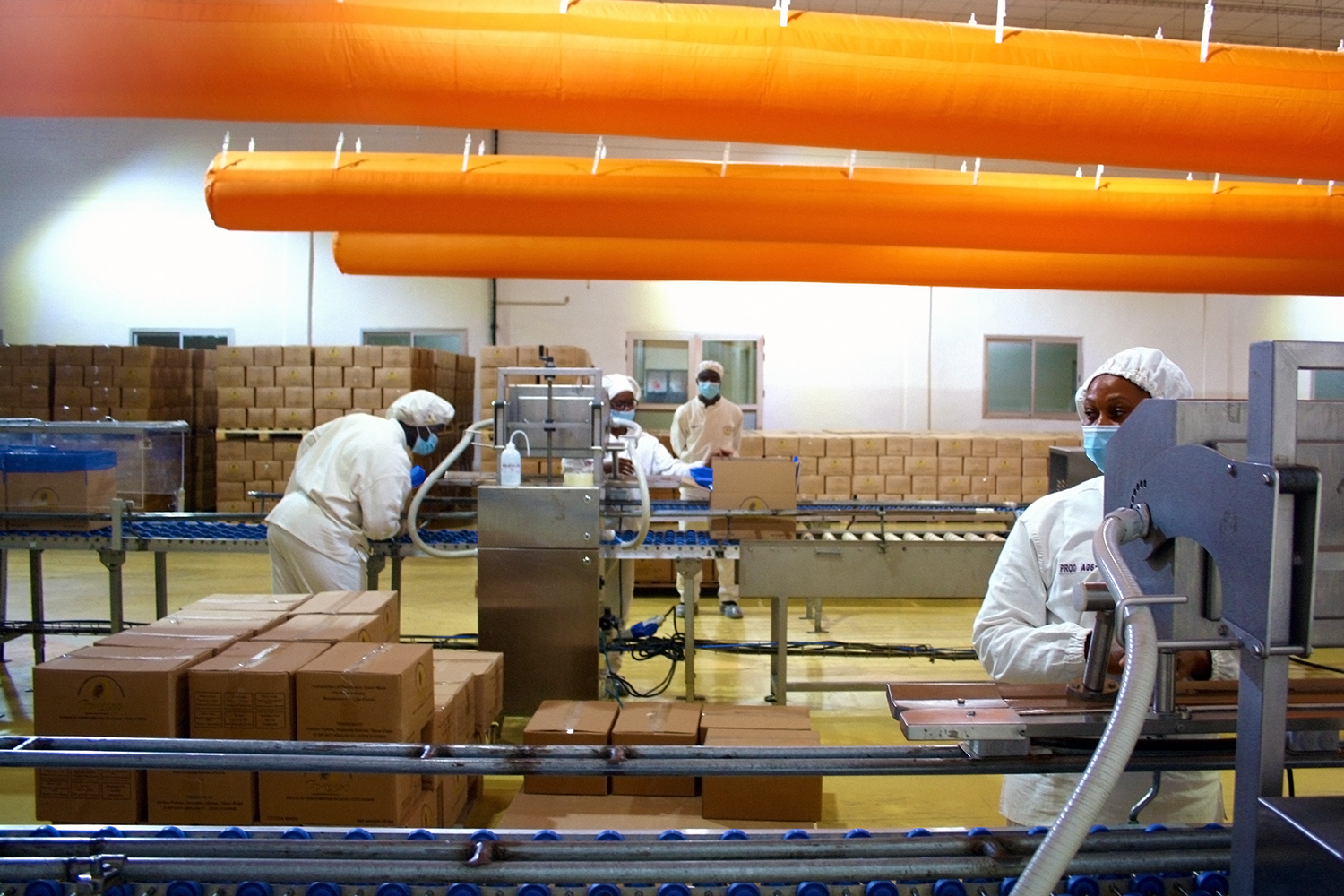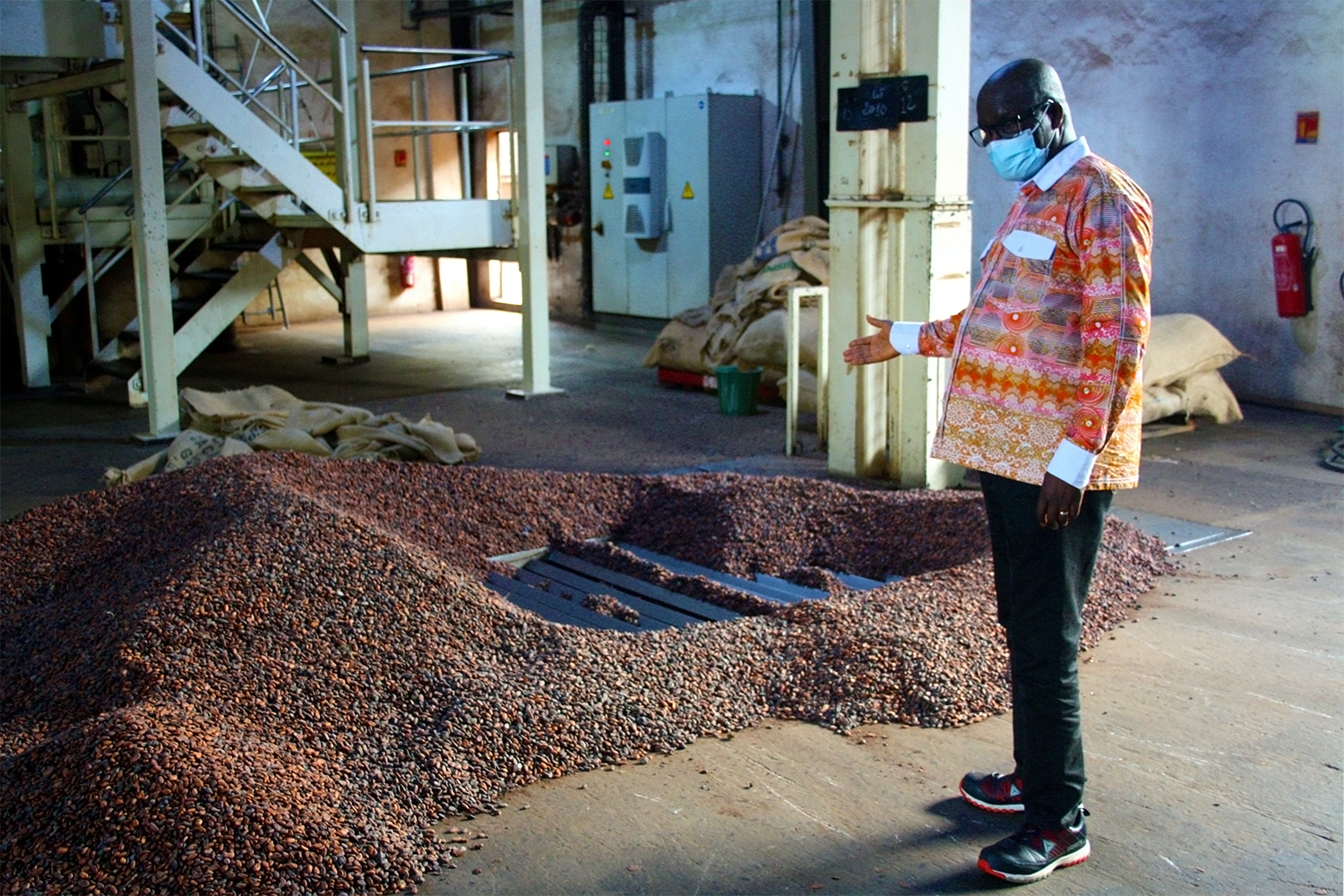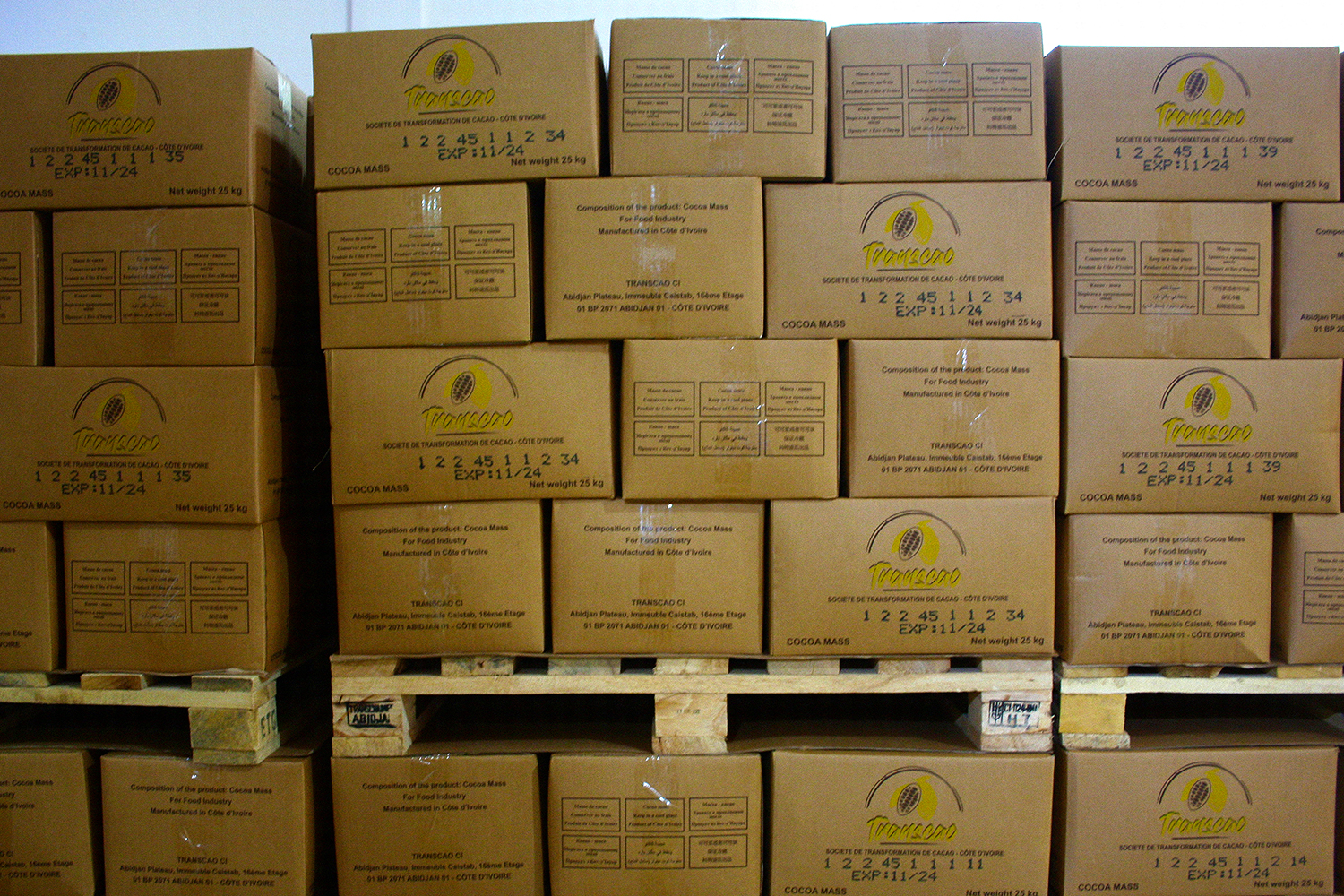West Africa wants more of Europe’s chocolate pie

Growing and exporting cocoa beans may be big business in Ivory Coast, but it’s low-margin and volatile. A government strategy to boost the processing sector could give the country a more profitable and stable bite of the chocolate bar.
Native to Central and South America, cocoa cultivation in West Africa has first been recorded as far back as 1868. The archives of the Royal Botanic Gardens in Kew refer to a few cocoa trees that were thriving on the property of the Swiss missionary charity Basel Mission in Akropong in what was then known as the British Crown colony of Gold Coast. Today, the West African countries of Ivory Coast and Ghana produce over 60% of the world’s cocoa beans and Switzerland has become synonymous with chocolate.
This mutually beneficial relationship has come under strain in recent years. Ivory Coast and Ghana are no longer satisfied with their meagre slice of $6 billion of the $120 billion chocolate industry. Switzerland, along with the European Union and the US, is unhappy about deforestation and child labour in cocoa growing regions of West Africa. Both sides are applying pressure on each other to get what they want but the power balance is still heavily skewed in favour of the cocoa consumers compared to the cocoa producers. The combined revenue earned by Swiss chocolate makers Nestlé (confectionery only), Lindt & Sprüngli and Barry Callebaut in 2021 was more than three times the combined value of cocoa beans exported by Ivory Coast and Ghana the year before. As major stakeholders they are also shaping what cocoa production will look like in the future.
This series of six articles will look at how West Africa is trying to renegotiate its role in the chocolate industry. From joining forces and adding value to investing in digitisation and sustainability. It is an uphill battle but a necessary one to avoid being held hostage by global cocoa prices and ensuring a livelihood for the five million cocoa farmers in the region.
For decades West African cocoa producers looked on from the sidelines as the most profitable chunk of the chocolate industry was being pocketed by Europe, the world’s biggest manufacturing bloc. As recently as 2021, when the global chocolate market was worth $113 billion, Europe accounted for the lion’s share — 47%, according to a report by American market research firm Grand View Research.
It’s little surprise that African countries have been battling for a bigger slice of the pie by moving up the value chain. As well as growing and exporting raw beans, they have set their sights on the higher-margin business of cocoa processing – roasting and then grinding the beans into processed products including powder, paste, cake and butter that are used to make chocolate.
Ivory Coast, the world’s largest producer of cocoa beans, accounting for around 43% of the global total, has been leading the way.
Closer to home
Although the government was already offering incentives to companies to boost domestic processing capacity, in 2020, President Alassane Ouattara set an ambitious target of processing 100% of Ivorian cocoa beans on home soil by 2025 (the current status is around 33%), a deadline that was subsequently pushed back to 2030. The government also decided to increase state investment in cocoa processing facilities even though foreign processors were already boosting their footprint.
Last October, the head of the Ivorian cocoa board, Yves Brahima Koné, estimated that a combination of public and private investment will push the country’s processing capacity past the one million tonne mark by the end of autumn 2023.
According to the International Cocoa Organization (ICCO), in the 2021/2022 cocoa year which runs from October to September, the West African nation only processed 675,000 tonnes of cocoa beans, a third of the harvest of 2.1 million tonnes. The remaining 1.4 million tonnes were exported as raw beans mainly to Malaysia and the Netherlands where they were processed and sold on to manufacturers.
The country’s focus on expanding its processing capacity could be prescient as European chocolate manufacturers come under increasing pressure to ensure they are sourcing ingredients ethically and in a way that promotes sustainability.
Swiss chocolate producers have traditionally imported most of their processed cocoa products from Europe which makes it difficult to trace their origin. Data show that only 1% to 2% of the world’s cocoa bean harvest is processed the country, with most processed cocoa products like cocoa powder and cocoa butter coming from the Netherlands, the main cocoa processing hub in Europe and the world’s biggest importer of cocoa beans that are mainly sourced from Ivory Coast.
Buying processed cocoa products closer to the farms where the beans are grown will help chocolate makers keep track of the source of their ingredients according to Swiss food giant Nestlé, which makes a range of mid-market confectionery including Kit-Kat and Smarties.
“We believe that an increased grinding capacity in the origin countries could help increase transparency and traceability in the cocoa supply chain and help add more value in origin countries,” a Nestlé spokesperson told SWI swissinfo.ch.
Ouattara’s pledge built on existing government policies to encourage investment in domestic cocoa processing. In 2017 it reintroduced financial incentives to multinational processors like Switzerland’s Barry Callebaut and US commodities giant Cargill to encourage them to invest more in the domestic processing sector. Export taxes on processed cocoa products were cut for companies that committed to expanding their facilities within a five-year window. Instead of a blanket rate of 14.6%, taxes on exports of cocoa butter were reduced to 11%, cocoa mass to 13.2% and cocoa powder to 9.6%.
The inducements worked. Zurich-based Barry Callebaut, which bills itself as the world’s leading manufacturer of high-quality chocolate and cocoa products, was the biggest cocoa processor in Ivory Coast, with a capacity of almost 200,000 tonnes through its subsidiary Société Africaine de Cacao (SACO). In 2019, it inaugurated a processing unit near the capital Abidjan on the South Atlantic coast, part of a CHF55 million investment spread over five years to expand its processing capacity in the country by 40%.
Cargill has also taken advantage of the tax incentive, completing the expansion of its facility in Youpougon, a suburb of Abidjan, by 50% in 2021 at a cost of $100 million. This will boost the company’s capacity from 110,000 tonnes to 170,000 tonnes.
China muscles in
The government’s foray into cocoa processing is being carried out mainly through Transcao, a special-purpose vehicle set up by the country’s cocoa board.
In 2019, the company took over a plant in San Pedro, a city in the southwest that is the country’s second-biggest port. The facility was originally owned by one of the country’s biggest cocoa exporters but, laden with debt, the company went into liquidation in 2018. The plan is to expand its capacity to 50,000 tonnes from 30,000 tonnes by installing a second production line by the end of 2023.

“We inherited a factory that was not producing the best quality on the market,” Marc Toba, the site manager, told SWI swissinfo.ch as he took our reporter on a tour of the premises. “Our challenge was to reverse the trend, and that’s what we managed to do.”
The plant currently only makes cocoa paste. “Once the factory is fully ready, we will produce cocoa butter, cake and powder that will be sold on international markets,” Toba said. “We also hope to make chocolate melt.”

The semi-finished cocoa products are sold to chocolate makers in the US, Europe, and Asia through a partnership with French group Touton and American firm KSW Global.

Transcao was also behind a new factory in Youpougon, which will have a capacity of 50,000 tonnes. President Ouattara himself laid the cornerstone at a ceremony in September 2020, saying the plant would not only “generate added value and jobs for Ivorians, but also revenue for the state budget. The project will considerably improve the volume of investments already made in our country.”
Among the VIPs at the ceremony was a delegation from the Chinese embassy. China has become a major source of investment finance for cocoa processing in Ivory Coast and has so far provided some 216 billion CFA francs (CHF354 million, $388 million) of loans which also cover the construction of two storage warehouses, with total capacity of 300,000 tonnes, to store cocoa beans for sale at elevated prices at times of high demand.
In return, China will get preferential access to Ivory Coast cocoa, with 40% of the output from the two Transcao factories reserved for Chinese companies. In addition, the mandate to supervise construction work was awarded to China Light Industry Design Co (CNDC), a subsidiary of state-owned giant China Haisum Engineering. The 100,000-tonne increase in Transcao’s processing capacity funded by China is expected to boost Ivory Coast’s total processing capacity by 14% and push it over 800,000 tonnes when the plant becomes operational (estimated fourth quarter of this year).
Although the per capita consumption of chocolate is very low in China at 0.5kg (compared with 11.3 kg for world leader Switzerland), Africa’s share of cocoa exports to China jumped from 0.6% to 5.6% between 2001 and 2020, according to the International Trade Centre. This is mainly in the form of processed cocoa products: demand for cocoa powder and cake more than doubled from 882 tonnes in 2018/2019 to 1,935 tonnes in 2019/2020 before the Covid-19 pandemic hit.
More competition
While the cocoa processing sector in Ivory Coast has been dominated by Barry Callebaut, Cargill, and Olam, which bought ADM’s cocoa business in 2015, the country is attracting new investors, especially from Asia. That’s partly due to a preferential trade deal with the European Union (EU) known as an Economic Partnership Agreement (EPA) which took effect in 2016. With the exception of arms and ammunition, the EU grants 100% duty-free and quota-free access to all imports from Ivory Coast and Ghana.
Singaporean food company JB Foods, whose main business is the production and sale of cocoa ingredient products, broke ground on a 60 million euros (US$63m) plant in Youpougon in June 2022 that is expected to be operational by the fourth quarter of 2024 with a capacity of 50,000 tonnes a year.
Another big Asian investor is Malaysian firm Guan Chong Berhad – the world’s fourth-biggest cocoa processor. The company has spent RM120 million ($27 million) on a new 60,000-tonne capacity processing plant in San Pedro that became operational in November 2022.
Guan Chong Berhad said the main incentives that drew it to Ivory Coast were zero corporate tax in the first five years (followed by a 50% cut on the normal rate for the following five years), zero customs duty on the import of certain processing machinery, and zero export duties on its products when entering the European market.
“Therefore, we will be able to produce single-origin cocoa ingredients from Ivory Coast to meet the growing demand of premium chocolate in Europe, with the help from our industrial chocolate subsidiary SCHOKINAG-Schokolade-Industrie in Germany,” managing director and CEO Brandon Tay told SWI swissinfo.ch via email.
Structural shift
The ICCO forecasts that West Africa’s cocoa processing capacity will continue to increase.
“Tax incentives and, in state-regulated domestic markets, subsidies for the processing of the mid-crop harvests are the major policy tools,” said ICCO spokesperson Carlos Follana.
Ivory Coast’s policies are contributing to a structural shift in the share of cocoa processed worldwide, especially for semi-finished products that have lower margins. Africa’s share of processing grew 8% in the 2021/2022 cocoa year. In contrast, Europe, which remains the world’s top cocoa grinder, saw growth of just 2.3%, although the impact of the war in Ukraine may have played a part in the sluggish increase due to rising energy costs according to the ICCO’s quarterly cocoa market report published in September 2022.
North America – which accounts for 18% of global cocoa processing – could be a sign of things to come for Europe. Grindings in North America fell by almost 3.5% in the 2021/2022 cocoa year. At the same time, net imports of semi-finished cocoa products rose by 22% in the first nine months of 2022, suggesting “that the drop observed in grindings in the region is somehow compensated by the importation of cocoa processed abroad,” the ICCO report noted.
Edited by Nerys Avery

In compliance with the JTI standards
More: SWI swissinfo.ch certified by the Journalism Trust Initiative










You can find an overview of ongoing debates with our journalists here . Please join us!
If you want to start a conversation about a topic raised in this article or want to report factual errors, email us at english@swissinfo.ch.